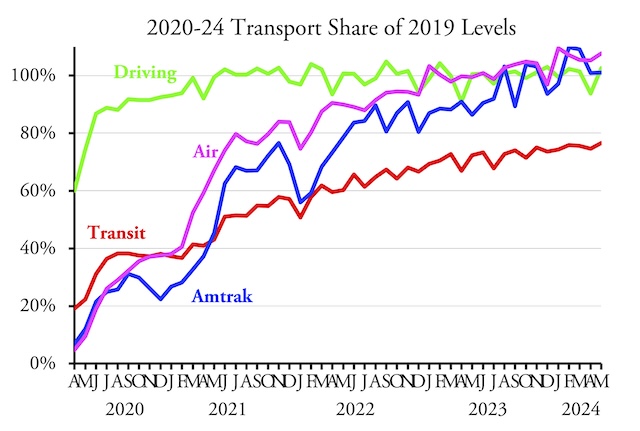Americans took 7.7 percent more airline trips in May 2024 than the same month in 2019, according to TSA passenger counts. While the release of airline passenger-mile data lags other data by a couple of months, March data indicate that domestic flying passenger-miles were 5.5 percent greater than in 2019 while international passenger-miles were 1.5 percent short of 2019. The number of international trips was 4.3 percent greater than in 2019, indicating that people who are traveling internationally are going to closer destinations.
Americans also drove 2.6 percent more miles in May 2024 than May 2019, according to data released last week by the Federal Highway Administration. Rural miles of driving were 8.8 percent greater than before the pandemic while urban miles were just 0.2 percent short of May 2019.
Meanwhile, transit systems carried 23.4 percent fewer riders than in May 2019, says the Federal Transit Administration’s monthly ridership release. While transit continues to lag well behind other modes, this is its best performance since the pandemic.
Ridership in Chicago, Philadelphia, Atlanta, Boston, Detroit, Phoenix, San Francisco, Minneapolis-St. Paul, Denver, St. Louis, Riverside-San Bernardino, Portland, Pittsburgh, and Charlotte continues to be well below average. Other urban areas, including New York, Los Angeles, and Miami, are doing better, but you have to go down the list to Salt Lake City, Richmond, and Tucson to find transit systems whose ridership has completely recovered from the pandemic. Richmond and Tucson, at least, achieved this by reducing transit fares to zero.
You can download my enhanced spreadsheet for complete transit data. This includes the FTA raw data in cells A1 through JS2291, annual totals in columns columns JT through KP, national and mode totals are in rows 2300 through 2319, transit agency totals in rows 2330 through 3329, and urban area totals in rows 3331 through 3821.
Amtrak passenger-miles were 1.1 percent greater than in 2019, according to the state-owned company’s monthly performance report. The Northeast Corridor is doing the best, carrying 11.2 percent more riders than in 2019. State-supported day trains carried 5.1 percent fewer ridership while long-distance transit carried 7.1 percent fewer. While Amtrak as a whole has at least recovered from the pandemic, it is still carrying only about 0.1 percent of the nation’s passenger-miles.









Excellent news from AP about driving and flights going up, and fortunately, transit continues its slow decline to irrelevance.
Also seeing good news on the climate front – as more warm weather in Las Vegas will lead more more folks to move there from congested, outmoded East Coast cities designed before the automobile:
https://x.com/WeatherProf/status/1810114040905052196
Sadly, many parts of the world inexplicably continue to heed AP’s advice, further constraining their citizens’ billions of miles driven, and thus their freedom and mobility.
https://www.bloomberg.com/news/features/2024-07-02/london-paris-seoul-show-commuting-power-of-fast-regional-rail
“In London, the 2022 debut of a transit line stretching the width of the metropolis quickly attracted more than half a million riders per day and promptly lifted the entire UK’s rail ridership above pre-pandemic levels. In Seoul, a blazing-fast subway that can exceed 100 miles (161 kilometers) per hour has cut travel times from the southern suburbs to the central business district by a factor of four. In Delhi, a similar system is under construction that will ultimately allow passengers to travel 100 km across the crowded megacity in just one hour. “
(Continue to FAIL to heed APs advice, I meant.)
Jane,
You need to get more realistic. You aren’t going to change people’s transportation habits. Despite what you say, even in Europe the vast majority of travel is by automobile. If you are concerned with climate change, the solution is to make automobiles more climate-friendly, not to get people to stop driving.
“Despite what you say, even in Europe the vast majority of travel is by automobile”
Show your numbers.
“If you are concerned with climate change, ..”
Are you? Last I read, you don’t believe in it, has that changed?
London slowest city in the world, New Delhi 44th.
https://www.tomtom.com/traffic-index/ranking/
Me thinks, urbanists imagine roads did not exist back then…….
But human civilization built LONG comprehensive road networks for conveyance of WHEELED vehicles for purpose of passengers and trade for thousands of years. Ones built by the romans lasted 700 years of neglect.
Car’s didn’t ruin cities; they clogged them with a new technology… but pre-cursor to old technology.
Cars were designed even within confines US urban constraints. They took up less space than Horse/carriage where children often trampled and streets inundated with schit…..Our streets before cars….Urbanists didn’t complain when that technology was replaced.
Cars didn’t ruin cities; De-population and Demographic changes did. Post WWII Men returned to work place, campus-style work replaced urban high rise office and dense building styles. Factories adopted new manufacturing techniques and new consumer products emerged and new consumer products and styles thanks to rise in telecommunications (TV/advertising) Automobile ownership permitted and advanced the leeway for upward mobility to pursue work/homes away limited transit/urban regimes.
“Congestion” is Orwellian Doublespeak for “traffic”
Yet Urbanists installed islands, narrowing avenues and lanes, cut access to streets for vehicles and reduced urban speed limits ALL lower vehicle thru-puts. Now wanna charge us to drive on roads they deliberately engineered for lower per hour thru puts? It’s like shooting someone in the leg, then saying, Look how slow you are, my brother across the street sells canes
It’s been 110 years, the war on the car is over, the car won. More less “Mobility” won….
I like the new American Dream Coalition website by the way! Looking forward to next year’s get-together!
http://americandreamcoalition.org/